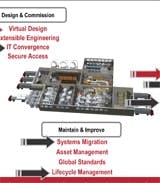Theater Showcases Benefits of Plant-Wide Optimization
Four theater presentations on the theme of plant-wide optimization provided a dramatic explanation of just what is possible in manufacturing today. The series of presentations was given in the exhibit-floor theater at Automation Fair 2009 this week in Anaheim, Calif.
Mike Burrows, Rockwell Automation marketing director, Integrated Architecture, first gave an overview of plant-wide optimization and its impact on time to market, productivity and supply chain, asset optimization, life-cycle cost and reliability.
He emphasized how smart, safe sustainable growth initiatives in process, information and safety can be enhanced by Integrated Architecture. "A core sustainable platform offers performance enhancements and optimum form factors for control, communications, visualization and I/O," said Burrows. "Multi-discipline control expands commonality of systems plant-wide and in new markets with real-time information, converged Ethernet and scalability dimensions. And knowledge integration connects entire systems with reusable intellectual property."
Data is manufacturing's greatest hidden asset because most companies are largely unaware of its existence, said Ted Hill, director of business development, in his presentation on engineering a real-time information architecture. "Data is hidden because it's inaccessible, incomprehensible and incongruent," said Hill. "Data often is difficult to obtain because of security, physical location and protocol. It's not always accessible because of people and distance. And raw data often is buried in complex table structures."
Click here to enlarge image and see detailed information.
Rockwell Automation's vision of plant-wide optimization encompasses all plant assets throughout their life cycle.
IT convergence has become a frequent topic of discussions in corporate boardrooms, explained Hill. "Chief information officers around the world are faced with similar challenges, all leading from decades of decentralized and disconnected application development. There are real benefits gained by convergence."He noted the use of standards that today ensure that multiple parties speaking the same language can communicate and synchronize. "Data consolidation allows views across data sources without replicating the data," said Hill. "Workflow management guides and enforces the business process, rather than relying on people to apply the prescribed processes. As time goes on, the topic of IT convergence becomes more and more important, as the cost to maintain existing infrastructure drops among the low-hanging fruit for cost-cutting activities."
In almost every manufacturing company, there is a virtual information barrier between the business workers in the office and the manufacturing floor. This barrier is technical and operational. "Often there are two networks in a manufacturing plant with very high levels of security between them or no connectivity at all," said Hill. "Information needed in the office, by other departments and by management is typically delivered periodically through systems like ERP. And almost all of it is reported weekly or monthly. Direct access to manufacturing systems is almost never granted to office workers, even direct supervisors of manufacturing operations."
The universal problem for these companies is the lack of adequate information needed to do their jobs effectively. "The people in the front office are starved for reliable, timely and accurate information about what's going on in manufacturing," said Hill. "If they get reports, they are typically on work completed, rarely on work in process. They are typically prepared by individuals based on whatever data they can easily obtain."
At the same time, data is piling up in the various manufacturing systems, such as control systems, HMI/SCADA, historians and alarm-and-event systems. And each of these systems often is from a different vendor, each creating its own silo of data because it has its own user interface, data structure, visualization and reporting paradigm. Plus, the information derived from each is intended to accomplish that system's primary function.
"It is not intended to correlate its own data with that of other systems or to provide composite reports beyond the scope of operations," explained Hill. "The barrier is solidified and operations suffer."
Asset utilization has become a key area of focus in today's economy as manufacturers are challenged with getting more out of their existing assets. "Real-time information provides an on-demand window into critical performance data, enabling management, operations, engineering and production personnel to quickly respond to issues affecting yields, product quality and plant uptime," said Hill. "Logix becomes the information-enabled platform feeding relevant data to FactoryTalk applications such as Historian, Metrics, Batch and AssetCentre. FactoryTalk VantagePoint becomes the common presentation layer, integrating this data along with data from the customer's business system to provide meaningful insight into plant operations. This is critical, as you can't improve what you can't measure."
With the right applications and data management framework, manufacturers can dramatically increase transparency. "Information is the next industrial revolution," said Hill. "The connected enterprise has a competitive edge."
Rob Swim, process channels, global program manager, explained in his presentation on achieving flexible operations through plant-wide control that certain pressures are being placed on manufacturers. "Other marketplace demands include improving your time to market and information exchange," he said. "For example, getting new products to market quickly and being able to react to market changes is critical. And customers want orders filled on time every time. These demands put pressure on you to hold, if not improve, your quality standards."
Supply chain management also has an effect. "There's a push to show real-time information from suppliers to customers," said Swim. "Sharing data is critical in today's world and will become even more so as time moves on. This drives the need for you to share more information between the process side of your facility and the packaging side, and from the plant floor to the back office MES and ERP systems."
He noted four questions customers need to answer: How do we effectively leverage our operations investment to meet changing customer demands? How can we enhance our business systems by managing data from the plant floor, incorporating this information in our planning process? Have we integrated production, maintenance and quality processes to maximize output and minimize downtime? Can we better address regulatory needs to reduce their impact on operations performance? "The PlantPAx process automation system can answer all of those questions," he said.
"Last year we introduced the creation of the PlantPAx process automation system," said Swim. "This system leverages all of the core aspects of Integrated Architecture, but also expands on the system to take on unique process and DCS-like capabilities. We enable customers to migrate DCS systems within one scalable environment for unmatched operational flexibility and visibility, integrate with industry leaders for engineering library deployment tools, create value for skid builders and process OEMs to become a direct extension of the plant system. Ultimately, plant-wide control is a unique approach which is the anchor point to driving continuous process optimization and reducing operational risk."
Swim also discussed system migration. "All of the great business values of plant-wide optimization are realized through system migration," he said. "The challenge in today's economy is to incrementally grow capabilities of the system, increase its functional life and do so at the lowest risk to daily operation with minimal capital outlays."
To accomplish this, Swim suggested a common approach to both competitive conversions and migrations from older Rockwell Automation systems. "Most automation suppliers focus either on complete replacements of existing systems to get the promised value or apply lots of software and services on top of already limited systems to extract data. Our approach is to embed migration functions such as third-party communications capabilities and I/O scanning into the architecture."
Migration modernizes, but also eliminates islands and increases system capability, explained Swim. "Instead of doing separate and complete rip-and-replace approaches to DCS or PLC systems, or using OPC servers to access the installed base, our increased capabilities in Integrated Architecture extend real-time information with data servers in the control layer and provide a multi-discipline environment to flatten the plant architecture. The result is a scalable approach with reduced risk and at the lowest cost to incrementally gain the benefits of a modern system as the basis for current and future plant-wide optimization."
In his program about doing more with less through efficient maintenance, Kevin Jacobson, interim marketing director, services & solutions, explained the state of plant maintenance and how technology can help to create continuous improvement throughout the enterprise and the plant lifecycle.
"Maintenance is facing some tough challenges today," said Jacobsen. "But we can be more efficient and get more accomplished with fewer resources by effectively scheduling and managing production throughout the plant. Every function on the plant floor plays a role in helping to achieve this goal. And your automation system can support your optimization efforts."
"The first issue putting pressure on maintenance today is the age and condition of equipment and plant assets," said Jacobson. "At last year's Automation Fair, we asked manufacturers their top barrier to higher performance, and 65% mentioned the age of their machines as the number one challenge. In addition, nearly three-quarters of all U.S. manufacturing plants are more than 25 years old. It's a deadly duo to have aging equipment and an equally aging infrastructure to maintain. This issue of aging equipment is a very real challenge affecting our ability to optimize plant performance."
Another issue impacting maintenance is the maturing workforce and rate of retirement of critical knowledge holders on the plant floor. "When we asked which trends will have the most impact on operation, 36% told us the loss of institutional knowledge was a huge threat," said Jacobson. "Companies are reporting 30-50% retirement rate of maintenance technicians in the U.S. And in Japan, it's even more serious with a 60-80% retirement rate among experienced operators and maintenance personnel projected over the next five years."
The economy also is taking its toll. "Equipment upgrades and capital improvement activities have been severely curtailed, if not cancelled," said Jacobson. "There are higher requirements for commercial financing, longer return-on-investment periods and basic uncertainty in the markets. All of this has caused companies to place a stranglehold on capital funding and delay critical investments."
Companies have looked for productivity gains wherever they can find them. One thing is clear, said Jacobson. "We have to find a way to do more with less," he said. "We believe we can help plants be more efficient and productive with aging equipment, maturing and smaller workforces and less available capital with our services-and-support capabilities."
Rockwell Automation meets everyday technical needs with on-demand transactional services available when and where they're needed, said Jacobson. "InSite Managed Services help our customers sustain the value of their manufacturing technology investment," he said. "Imagine in this age of reduced resources, a growing skills gap and financial pressure, if you had a global team of Rockwell Automation engineers intimately familiar with your site and your systems who are available 24/7. Our team becomes a virtual extension of plant engineering and manufacturing IT resources."


